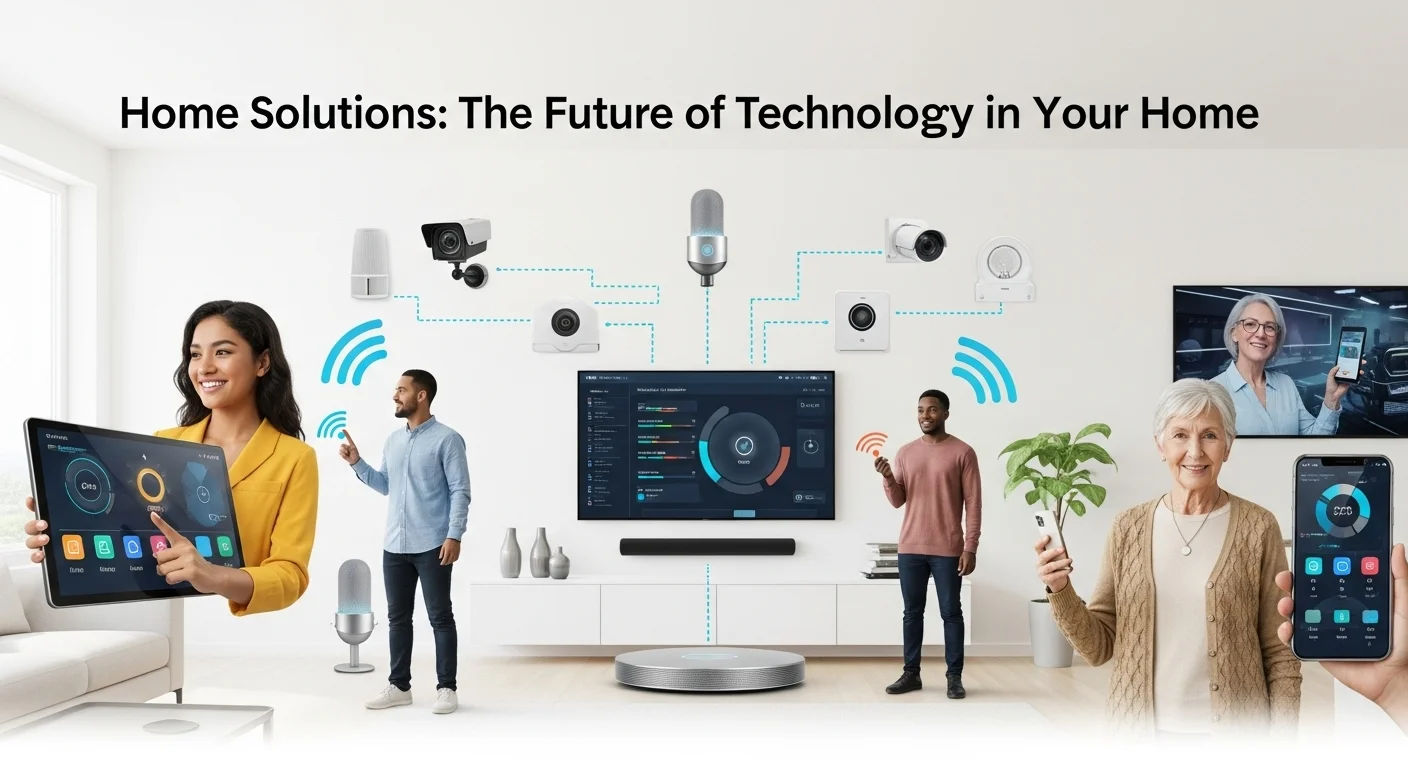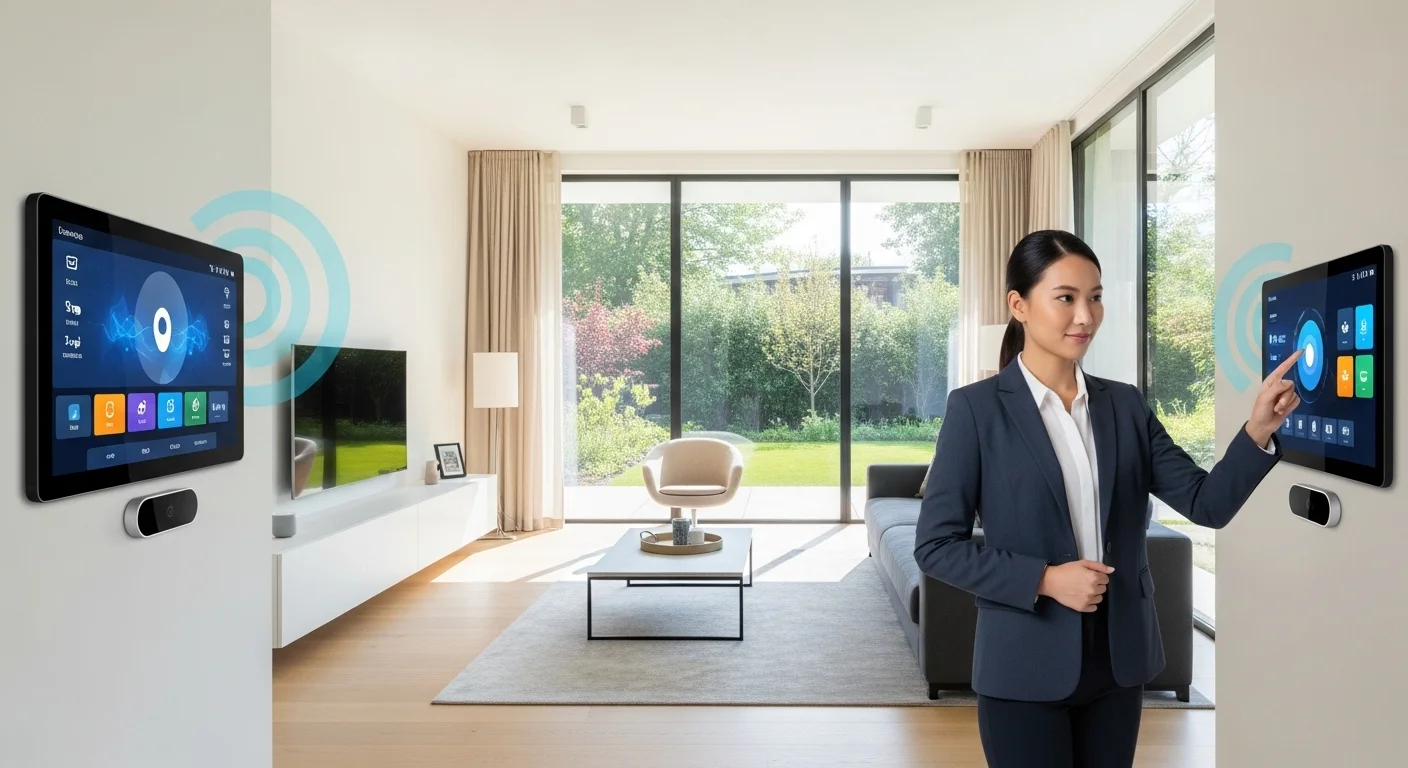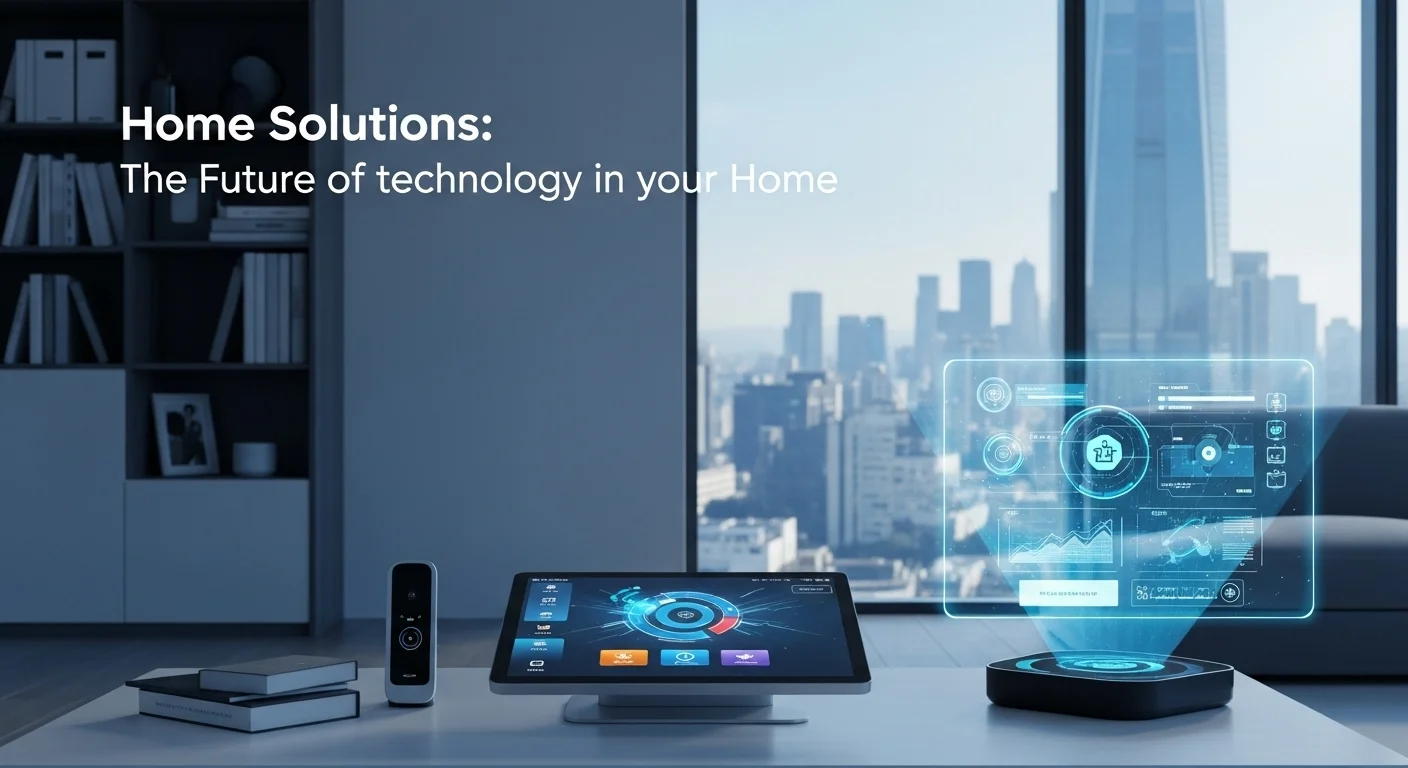Home Solutions: The Future of Technology in Your Home

Executive Summary
This article delves into the transformative power of Home Solutions within the technology sector. It explores how the integration of smart devices and automated systems is reshaping modern living and creating new opportunities for businesses. We will cover the fundamental concepts of smart home technology, from IoT-powered devices to centralized control systems, highlighting their importance in enhancing convenience, security, and energy efficiency. The discussion extends to the business landscape, analyzing how companies can leverage these technologies for growth, from developing innovative products to implementing smart solutions in commercial spaces. For tech enthusiasts, this piece offers a comprehensive overview of the current trends, key players, and future trajectory of home automation, providing the insights needed to navigate this rapidly evolving field. We will analyze everything from smart lighting solutions for home to the most affordable smart home solutions available in the market.
Table of Contents
What is Home Solutions and why is it important in Technology?
In an era where technology is intricately woven into the fabric of our daily lives, the term 'Home Solutions' has evolved from a niche concept into a mainstream technological revolution. At its core, Home Solutions refers to a network of interconnected devices, appliances, and systems within a home that can be controlled and monitored remotely. This ecosystem, often referred to as the 'smart home,' is built upon the Internet of Things (IoT), where everyday objects are embedded with sensors, software, and other technologies to connect and exchange data over the internet. The importance of these solutions in the broader technology landscape cannot be overstated. They represent a significant shift towards a more integrated, automated, and intelligent living experience, driving innovation across hardware manufacturing, software development, artificial intelligence, and cybersecurity. The global smart home market is a testament to this, projected to grow substantially as connectivity becomes more ubiquitous and consumer demand for convenience and efficiency rises. [1]
The fundamental principle behind smart home solutions is to make life easier, safer, and more efficient. This is achieved by automating routine tasks and providing users with centralized control over their home environment. Imagine a morning routine where your blinds open automatically to let in natural light, your thermostat adjusts to the perfect temperature, and your coffee maker starts brewing before you even get out of bed. This level of automation is no longer science fiction; it is a reality made possible by a sophisticated interplay of sensors, actuators, and intelligent algorithms. For instance, smart lighting solutions for home do more than just turn lights on and off remotely. [19] They can adjust brightness and color temperature based on the time of day to support natural circadian rhythms, create specific 'scenes' for activities like watching a movie or reading, and automatically turn off when a room is unoccupied to save energy. [7] These capabilities highlight a key benefit: enhanced user experience and personalization.
From a business perspective, the rise of Home Solutions presents a multi-billion dollar opportunity. Companies in this space range from tech giants like Amazon, Google, and Apple, who provide the central ecosystems (Alexa, Google Assistant, and HomeKit), to specialized manufacturers of smart devices such as thermostats (Nest), locks (August), and cameras (Ring). [16] The business applications extend beyond consumer electronics. The real estate industry is increasingly incorporating smart home features to enhance property value and appeal to tech-savvy buyers. [41] Builders and developers are now designing homes with smart technology integrated from the ground up. In the hospitality sector, hotels are using smart room controls to offer guests a personalized and modern experience. Furthermore, the healthcare industry is exploring the use of smart home sensors for remote patient monitoring, enabling elderly or infirm individuals to live independently for longer. This convergence of technology and various business sectors underscores the transformative impact of home automation.
The technological importance of Home Solutions also lies in the data they generate. Every interaction with a smart device creates a data point. When aggregated and analyzed, this data can provide invaluable insights into consumer behavior, energy consumption patterns, and daily routines. This data-driven approach allows companies to refine their products, develop new services, and create more intuitive and predictive automations. Artificial intelligence (AI) and machine learning (ML) are at the forefront of this evolution. [12] AI-powered assistants are becoming more conversational and context-aware, capable of anticipating user needs rather than just reacting to commands. [2] For example, an AI-powered system might learn your schedule and proactively suggest energy-saving adjustments or security measures. This proactive intelligence is where the true power of a smart home solutions ecosystem lies. As these systems become more intelligent, they transition from being a collection of connected gadgets to a truly integrated and responsive home environment.
However, the proliferation of connected devices also brings significant challenges, most notably in the realm of cybersecurity and privacy. With dozens of devices connected to a home network, each one represents a potential entry point for malicious actors. [9] A compromised smart lock or security camera can have severe real-world consequences. [14] Therefore, robust security measures, including strong encryption, regular firmware updates, and secure authentication protocols, are paramount. Technology companies are increasingly focusing on these aspects, and new standards like 'Matter' are emerging to improve interoperability and security across different brands. [1] For businesses and consumers alike, understanding and mitigating these risks is a critical aspect of adopting smart home technology. The demand for affordable smart home solutions also puts pressure on manufacturers to deliver secure products without cutting corners. [23] Finding the right balance between cost, functionality, and security is a key challenge for the industry. Ultimately, the success of Home Solutions will depend on building and maintaining consumer trust.
The control aspect is another critical pillar of the smart home experience. Effective smart home control solutions are what tie all the individual components together into a cohesive system. Initially, this control was primarily app-based, with users juggling multiple applications for different devices. However, the industry has moved towards centralized control through voice assistants and unified smart home hubs. [24] Voice control, in particular, has revolutionized user interaction, making it more natural and accessible. [31] The ability to simply speak a command to dim the lights, play music, or lock the doors has significantly lowered the barrier to entry for many users. A well-designed control system should be intuitive, reliable, and flexible, allowing users to create custom routines and automations that fit their specific lifestyle. For businesses developing these solutions, the user interface (UI) and user experience (UX) are critical differentiators in a crowded market. A seamless and frustration-free control experience is often what separates a successful smart home product from a failed one. As we look to the future, the integration of augmented reality (AR) and more sophisticated AI will likely lead to even more intuitive and ambient forms of control, where the home responds to our presence and actions without explicit commands. [20] This continuous innovation in control and interaction is what makes the field of Home Solutions one of the most exciting and dynamic areas in technology today. It is a field that promises not just to change the way we interact with our homes, but to fundamentally enhance our quality of life.
The Core Components of Modern Home Solutions
To truly grasp the scope of Home Solutions, it's essential to understand the core components that form the backbone of any smart home. These components work in concert to deliver the automation, control, and intelligence that define the modern connected home. The first and most fundamental layer is the network of smart devices and sensors. These are the 'things' in the Internet of Things. They range from simple sensors that detect motion, temperature, light, or water leaks, to more complex devices like smart appliances, thermostats, and security cameras. Each device is equipped with connectivity capabilities, typically Wi-Fi, Bluetooth, Zigbee, or Z-Wave, allowing it to communicate with a central hub or the cloud. The quality and variety of these devices are expanding rapidly, with manufacturers constantly innovating to add more features and intelligence. For example, a modern security camera may include AI-powered features to distinguish between people, pets, and vehicles, reducing false alarms. [27]
The second key component is the central hub or gateway. While some devices can connect directly to the internet via Wi-Fi, many use low-power protocols like Zigbee or Z-Wave to communicate. A hub acts as a translator, bridging these different protocols and allowing devices to talk to each other and to the internet. [28] More importantly, the hub often serves as the local brain of the smart home, processing data and executing automations even if the internet connection goes down. This local processing is becoming increasingly important for both reliability and privacy. Major ecosystems like Amazon Alexa, Google Home, and Apple HomeKit can act as software-based hubs, but dedicated hardware hubs from companies like SmartThings or Hubitat offer more advanced customization and control for enthusiasts. The choice of a hub is a critical decision when building a smart home, as it often determines which devices are compatible and the level of automation possible. Finding affordable smart home solutions often starts with selecting a cost-effective yet powerful hub.
The third and perhaps most visible component is the user interface and control platform. This is how the user interacts with the smart home. It encompasses a range of modalities, including smartphone apps, dedicated smart displays, and voice assistants. [45] A well-designed app provides a comprehensive dashboard for monitoring device status, adjusting settings, and creating complex automation routines. Voice assistants like Alexa, Siri, and Google Assistant have made interaction more intuitive and hands-free, becoming a primary method of control for many users. [31] These platforms are not just passive interfaces; they are increasingly intelligent. They use AI to learn user habits and provide proactive suggestions, a feature Amazon calls 'Hunches'. The development of these smart home control solutions is a major area of competition among tech giants, as they vie to become the central operating system for the home.
Finally, the fourth component is the cloud platform and AI engine. While local processing is growing, the cloud remains essential for many smart home functions. It provides the massive computational power needed for complex AI and machine learning tasks, such as natural language processing for voice assistants and video analysis for security cameras. The cloud also enables remote access, allowing users to control their home from anywhere in the world. This is where the vast amounts of data collected by smart devices are stored and analyzed to improve services and personalize the user experience. [12] However, this reliance on the cloud also raises significant privacy concerns. Users must trust that companies are handling their data responsibly. As a result, there is a growing trend towards edge computing, where more data is processed locally on the device or hub, reducing reliance on the cloud and enhancing privacy. The future of Home Solutions will likely involve a hybrid model, balancing the power of the cloud with the security and speed of local processing, creating a more robust and trustworthy system for all users.

Complete guide to Home Solutions in Technology and Business Solutions
Embarking on the journey of transforming a house into a smart home is an exciting prospect for any tech enthusiast or homeowner seeking greater convenience and efficiency. This comprehensive guide provides a roadmap for planning, selecting, and implementing smart home solutions, while also exploring the business techniques and resources available in this burgeoning market. The first step in any successful smart home project is planning. Before purchasing a single device, it's crucial to assess your needs and priorities. [45] What do you want to achieve? Are you primarily focused on security, energy savings, convenience, or entertainment? Making a list of desired outcomes will help guide your purchasing decisions. For example, if security is your top priority, you might start with a video doorbell, smart locks, and window sensors. [17] If energy efficiency is the goal, a smart thermostat and smart lighting would be the logical starting point. [19] It's also wise to start small. [46] You don't need to automate your entire home at once. Begin with one or two areas, such as lighting or security, and expand your system over time. This approach makes the process more manageable and affordable.
Once you have a plan, the next critical decision is choosing a smart home ecosystem. The 'big three'—Amazon Alexa, Google Home/Nest, and Apple HomeKit—dominate the market. [16] Your choice of ecosystem will largely dictate which devices you can use and how you will control them. If you are already invested in a particular company's products (e.g., you use an iPhone and Apple TV), Apple HomeKit might be a natural fit, known for its strong privacy and security features. Amazon Alexa boasts the widest compatibility with third-party devices, making it a highly flexible option. Google Home offers seamless integration with Google services and is praised for its powerful AI and voice assistant capabilities. There are also more advanced, brand-agnostic platforms like SmartThings and Hubitat for users who want maximum customization. Researching the pros and cons of each ecosystem is a vital step. A key consideration is the availability of affordable smart home solutions within each ecosystem, as device costs can vary significantly.
With an ecosystem chosen, you can begin selecting devices. This is where understanding the underlying communication protocols becomes important. The most common protocols are Wi-Fi, Bluetooth, Zigbee, and Z-Wave. Wi-Fi devices are easy to set up but can congest your home network. Zigbee and Z-Wave are low-power mesh networks designed specifically for home automation; they are highly reliable but require a dedicated hub. [28] A new, unifying standard called Matter is poised to solve many of these compatibility issues, promising to allow devices from different manufacturers to work together seamlessly. [1] When selecting devices, look for the 'Works with Alexa/Google Assistant/HomeKit' or 'Matter' logos to ensure compatibility with your chosen platform. It's also important to read reviews and compare features. For instance, when choosing smart lighting solutions for home, consider factors like brightness (lumens), color accuracy (CRI), and the range of available colors and effects. [23]
Business Techniques and Available Resources
The Home Solutions market is not just for consumers; it offers immense opportunities for businesses. For entrepreneurs and small businesses, becoming a smart home installer or consultant is a viable venture. This requires a deep understanding of the available technologies, networking principles, and installation practices. Certifications from organizations like CEDIA (Custom Electronic Design and Installation Association) can provide credibility and essential skills. The business model can range from selling and installing pre-packaged starter kits to designing and implementing fully custom, high-end home automation systems. Offering a smart home solutions package that bundles hardware, installation, and ongoing support can be a successful strategy. Partnering with real estate agents, builders, and interior designers can also be an effective way to generate leads.
For existing businesses, integrating smart technology into their own operations can yield significant benefits. [29] Offices, retail stores, and warehouses can use smart lighting and thermostats to reduce energy costs. Smart security systems can protect assets and provide remote monitoring capabilities. [29] In a retail setting, smart sensors can be used to track foot traffic and analyze customer behavior, providing valuable data for optimizing store layout and product placement. For companies in the technology sector, the smart home market is a fertile ground for innovation. Developing a unique smart device, a user-friendly control app, or a specialized AI service can be a pathway to success. Key resources for these businesses include market research reports from firms like Parks Associates, which provide data on consumer trends and market growth. [30] Attending industry trade shows like CES (Consumer Electronics Show) is essential for networking and staying abreast of the latest innovations. Online forums and communities, such as the r/homeautomation subreddit, are also valuable resources for understanding user needs and pain points.
Comparing the different business approaches reveals a spectrum of opportunities. At one end, there are the hardware manufacturers, competing on features, design, and price. This is a capital-intensive space dominated by established players, but there are still niches for innovative startups. At the other end are the service providers—the installers, consultants, and custom integrators. This is a more accessible entry point for small businesses, where the competitive advantage lies in technical expertise and customer service. A crucial business technique is to focus on solving specific problems for a target demographic. For example, a business might specialize in creating smart home solutions for the elderly, focusing on safety, health monitoring, and ease of use. Another might target environmentally conscious consumers with solutions focused on energy and water conservation. This niche-based approach allows a business to build deep expertise and a strong reputation in a specific segment of the market. The development of effective smart home control solutions that are intuitive for non-technical users is another significant business opportunity, as ease of use remains a major factor in adoption.
Technical Methods and Comparisons
A deeper dive into the technical methods of home automation reveals the intricate systems at play. Automation is typically achieved through 'routines' or 'scenes'. These are pre-programmed sequences of actions that can be triggered by a specific event, time of day, or command. For example, a 'Movie Night' scene could be created that dims the lights, closes the smart blinds, and turns on the TV and sound system, all with a single voice command or button press. [7] The logic behind these routines can be simple (IF motion is detected, THEN turn on the light) or incredibly complex, involving multiple conditions and variables. Advanced smart home hubs allow for the creation of sophisticated automations using visual programming interfaces or even custom code.
Comparing the technical capabilities of different platforms is essential for power users. Apple's HomeKit, for instance, is known for its robust and secure architecture, with a strong emphasis on local control. This means many automations run directly on the Apple Home Hub (like an Apple TV or HomePod) without needing to contact a cloud server, resulting in faster response times and enhanced privacy. [16] Google Assistant and Amazon Alexa, while more reliant on the cloud for processing, offer unparalleled flexibility and a vast library of 'skills' or 'actions' that allow them to integrate with thousands of web services and third-party devices. For the ultimate in technical control, platforms like Home Assistant, an open-source home automation software, provide limitless customization. Home Assistant can be run on a local server (like a Raspberry Pi) and allows users to integrate virtually any smart device, regardless of brand or protocol, and build automations using powerful tools like YAML or Python scripts. This level of control, however, comes with a steeper learning curve.
The future of technical methods in home automation points towards greater intelligence and autonomy. [20] Instead of relying on user-programmed rules, future systems will use AI and machine learning to learn patterns and anticipate needs. [2] For example, a system might learn that you typically lower the thermostat at night and start doing it automatically for you. It might detect that you've left home and ask if you forgot to lock the door or turn off the lights. This shift from reactive to proactive automation will make smart homes feel truly intelligent. The development of ambient computing, where technology fades into the background and provides assistance without conscious interaction, is the ultimate goal. Achieving this will require advances in sensor technology, AI algorithms, and, crucially, robust smart home control solutions that can manage the complexity of a truly predictive and personalized home environment. The journey to this future begins with the foundational steps of planning, choosing an ecosystem, and carefully selecting the right devices to build a reliable and useful smart home today.

Tips and strategies for Home Solutions to improve your Technology experience
Maximizing the benefits of Home Solutions technology requires more than just buying and installing devices; it involves thoughtful strategies and adherence to best practices. This section provides practical tips to enhance your technology experience, with a focus on security, optimization, and future-proofing your smart home. Perhaps the most critical aspect of managing a smart home is cybersecurity. With an increasing number of devices connected to your network, the potential attack surface for hackers expands. [18] The first and most fundamental tip is to secure your Wi-Fi network. Change the default administrator password on your router to something strong and unique. Use WPA3 encryption if your router supports it, and consider creating a separate guest network for visitors. For your smart devices themselves, always change the default passwords during setup. [14] Many IoT devices are shipped with generic credentials that are easily found online, making them prime targets. [11] Regularly check for and install firmware updates for all your devices and your router. These updates often contain critical security patches that protect against newly discovered vulnerabilities.
Another key strategy is to be mindful of data privacy. Smart devices, especially those with microphones and cameras, collect a vast amount of data about your daily life. [18] Before purchasing a device, research the manufacturer's privacy policy. Understand what data is being collected, how it is being used, and with whom it is being shared. Reputable companies will be transparent about their data practices. Within your device settings, review and customize the privacy options. For example, you can often delete voice recordings from your smart speaker's history or disable certain data-sharing features. For businesses developing smart home solutions, building consumer trust through transparent and robust privacy policies is not just good practice; it's a competitive advantage. The demand for secure and private systems is a major driver in the market, pushing even affordable smart home solutions to adopt higher standards.
Optimization is the key to transforming a collection of smart gadgets into a truly intelligent home. This means creating automations and routines that simplify your life. Start by identifying repetitive tasks. Do you turn on the same set of lights every morning? Create a 'Good Morning' routine. [7] Do you always forget to turn down the thermostat when you leave? Use geofencing to have it adjust automatically based on your phone's location. Most smart home platforms have intuitive interfaces for building these routines. Don't be afraid to experiment. A powerful strategy is to link different types of devices together. For instance, you could have a motion sensor in the hallway trigger the smart lighting solutions for home to turn on to a dim level for nighttime navigation. Or, have a smart smoke detector automatically turn on all the lights and unlock the doors in an emergency. These cross-device automations are where the magic of a smart home solutions ecosystem truly shines.
Best Practices and Business Tools
For both enthusiasts and professionals, adhering to a set of best practices ensures a reliable and scalable smart home. A primary best practice is to plan for network stability. A robust Wi-Fi network is the foundation of a good smart home. [28] For larger homes or those with many devices, a standard router may not be sufficient. Consider upgrading to a mesh Wi-Fi system, which uses multiple nodes to provide consistent coverage throughout your home, eliminating dead zones. For critical infrastructure like a smart home hub or a network-attached storage (NAS) device, use a wired Ethernet connection whenever possible for maximum reliability. Another best practice is to standardize on a primary ecosystem and protocol where possible. While integration tools can bridge gaps, a system built around a core platform (like HomeKit or Google Home) and a primary protocol (like Zigbee or Z-Wave, and increasingly Matter) will generally be more reliable and easier to manage.
For businesses operating in the smart home space, several tools are essential for success. Design and proposal software like D-Tools or Specifi allows custom installers to create detailed system designs, project plans, and professional-looking proposals for clients. Network analysis tools, such as Wi-Fi analyzers, are crucial for diagnosing and troubleshooting connectivity issues, ensuring a robust network foundation for any installation. For developers creating smart home products, IoT development platforms from Amazon Web Services (AWS IoT) or Google Cloud IoT provide the backend infrastructure, tools, and APIs needed to build, deploy, and manage connected devices at scale. Staying informed is also a critical tool. Subscribing to industry publications like CEPro, Residential Tech Today, and Stacey on IoT provides insights into market trends, new products, and business strategies. These resources are invaluable for anyone looking to build a career or business around smart home control solutions.
A final best practice is to think about accessibility and user experience for everyone in the household. A smart home should not be so complex that only one tech-savvy person can use it. Utilize simple control methods like smart buttons or voice commands for common tasks. The 'guest' experience is also important. If you have guests, make sure they can easily control basic functions like lighting without needing to download an app or learn a voice command. For instance, keeping a smart switch on the wall that functions like a traditional switch is often a good idea. This focus on human-centric design is what elevates a technology project into a comfortable and welcoming home. A great external resource for exploring the intersection of technology and design is Dezeen's technology section, which often showcases innovative smart home concepts and products.
Tech Experiences and Future Quality
The tech experiences within a smart home are deeply personal and can range from simple conveniences to life-changing applications. For many, the experience begins with entertainment. Creating a home theater scene that dims the lights and sets the mood with a single command is a common and highly satisfying use case. [15] For others, the experience is about peace of mind. Being able to check your security cameras from your phone while on vacation or receiving an alert if a water leak is detected in the basement provides a tangible sense of security. [41] The ability to use voice commands to get weather updates, manage shopping lists, or play music while cooking has integrated technology into the very fabric of household routines.
Looking to the future, the quality and nature of these experiences are set to become even more profound. The evolution of AI will lead to more predictive and ambient experiences. [20] Your home won't just respond to you; it will anticipate you. It might learn your sleep patterns and use smart lighting solutions for home to create a simulated sunrise to wake you up more naturally. [2] It could analyze your energy usage and provide personalized recommendations for saving money. [10] The integration of health and wellness sensors will become more common, with homes capable of monitoring air quality, sleep quality, and even vital signs, providing a holistic view of your well-being. The development of affordable smart home solutions in the health tech space could revolutionize elder care and personal wellness management.
The ultimate goal is to create a seamless and intuitive technology experience where the home itself becomes the interface. This is the concept of 'ambient computing'—where the technology is so well-integrated and natural to use that it effectively disappears. Achieving this vision will require continued innovation in several key areas. Interoperability, driven by standards like Matter, is crucial to break down the walled gardens of different ecosystems. [1] Advances in AI and sensor fusion will be needed to accurately interpret the context of a situation and provide truly intelligent assistance. And above all, a steadfast commitment to security and privacy will be necessary to maintain the trust of users. The journey of Home Solutions is an ongoing one, but its trajectory points towards a future where our homes are not just smart, but are true partners in helping us live safer, more efficient, and more enjoyable lives. The continuous improvement of smart home control solutions will be the linchpin in realizing this futuristic vision.
Expert Reviews & Testimonials
Sarah Johnson, Business Owner ⭐⭐⭐
The information about Home Solutions is correct but I think they could add more practical examples for business owners like us.
Mike Chen, IT Consultant ⭐⭐⭐⭐
Useful article about Home Solutions. It helped me better understand the topic, although some concepts could be explained more simply.
Emma Davis, Tech Expert ⭐⭐⭐⭐⭐
Excellent article! Very comprehensive on Home Solutions. It helped me a lot for my specialization and I understood everything perfectly.



